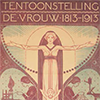De Vrouw 1813-1913-2013
DOI:
https://doi.org/10.18352/bmgn-lchr.10038Keywords:
History, Low Countries, Netherlands, Belgium, gender, women's historyAbstract
Women 1813-1913-2013: Introduction
In their introduction to the theme of this issue Mieke Aerts and Lex Heerma van Voss sketch very briefly a number of differences between contemporary gender history and women’s history as it emerged in the 1970s. They see gender history as moving away from a narrow focus on equal rights and emancipation: nowadays, gender is studied as a complex historical and social category, in creative dialogue with other important ‘turns’ in historiography, as epitomised by postcolonial and transnational history. In this way the articles in this issue are able to demonstrate that subjects such as consumer culture, labour relations, education and religion, are not only very relevant to gender historians, but also make a crucial contribution to our understanding of modern Dutch history.
This article is part of the special issue 'De Vrouw 1813-1913'.
In deze inleiding op het themanummer schetsen Mieke Aerts en Lex Heerma van Voss zeer globaal hoe hedendaagse gendergeschiedenis zich onderscheidt van vrouwengeschiedenis zoals die in de jaren zeventig van de twintigste eeuw ontstond. Het verschil is vooral gelegen in het verschuiven van de focus op emancipatie en gelijke rechten van vrouwen naar aandacht in den brede voor de complexe werking van sekse of gender als maatschappelijke categorisering. Op die manier treedt gendergeschiedenis in creatieve dialoog met bijvoorbeeld postkoloniale en transnationale wendingen in de geschiedschrijving en wordt zichtbaar dat thema’s als consumentencultuur, arbeid, opvoeding en religie niet alleen relevant zijn voor gendergeschiedenis, maar meer in het algemeen voor een beter begrip van het moderne Nederland.
Dit artikel maakt deel uit van het themanummer 'De Vrouw 1813-1913'.
Downloads

Downloads
Published
Issue
Section
License
Authors who publish with this journal agree to the following terms:
a) Authors retain copyright and grant the journal right of first publication with the work simultaneously licensed under a Creative Commons Attribution 4.0 International (CC BY 4.0) that allows others to share the work with an acknowledgement of the work's authorship and initial publication in this journal.
b) Authors are able to enter into separate, additional contractual arrangements for the non-exclusive distribution of the journal's published version of the work (e.g., post it to an institutional repository or publish it in a book), with an acknowledgement of its initial publication in this journal.
c) Authors are permitted to post their work online (e.g., in institutional repositories or on their website) prior to and during the submission process.
Authors are explicitly encouraged to deposit their published article in their institutional repository.







